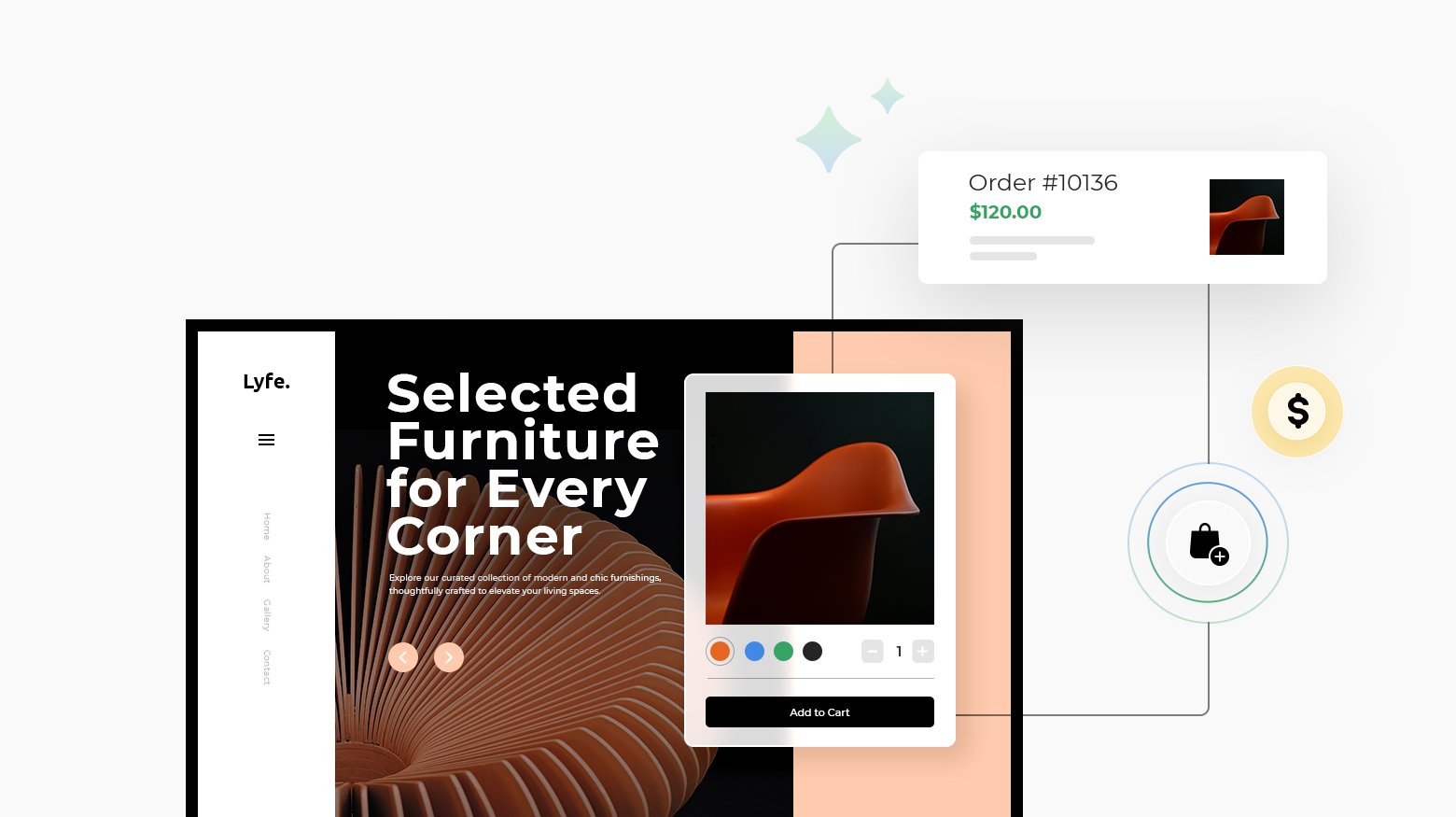A decade ago, selling jewelry meant showing your pieces at a boutique, attending craft fairs, or hoping a local store would carry your pieces. Fast forward to today, and jewelry ecommerce is booming with global online jewelry sales expected to reach about $117 billion by 2027, driven by digital-first shopping habits, social media trends, and the growing demand for unique, handmade, and custom pieces.
Think about this; brands like Mejuri and Ana Luisa built multi-million-dollar businesses selling jewelry online. And it’s not just big names. Independent designers and small business owners are growing in this space, too. No matter if you make handmade rings, sell vintage finds, or offer luxury pieces, it’s easier and more profitable today to sell jewelry online.
But how do you break in and stand out? Let’s discuss practical, actionable steps that turn your creativity into a thriving ecommerce brand.
The online jewelry market: Trends & how to sell jewelry online
The online jewelry market is a fast-growing, ever-evolving space full of opportunity. Understanding the trends and what buyers want will make you different from the competitors, otherwise, you won’t be able to tailor your online presence to the trends and needs in the market.
Market trends & statistics
The online jewelry market is experiencing significant growth. According to Technavio, the market is projected to expand by $78 billion from 2025 to 2029, boasting a compound annual growth rate (CAGR) of 22.1%.
Consumer behavior & preferences
Today’s shoppers are smart, well-informed, and selective. They don’t purchase on impulse but research, compare, read 27 reviews, and zoom in on every product image before deciding. If they sense anything off (unclear materials or questionable quality) they’ll expose it in a review faster than you can say ‘refund’.
Here is what buyers are looking for when they buy jewelry online:
- High-quality images and videos that capture every facet of the piece.
- Clear information about materials, sourcing, and craftsmanship.
- Reviews and testimonials from fellow customers to build trust.
- An intuitive website with easy navigation and secure payment options.
- Trust and convenience.
- A strong brand reputation.
Setting up your online jewelry business: From idea to launch
So, you’re ready to start a jewelry online business. Are you wondering where to begin? While it’s tempting to jump straight into designing and listing products, you know, the fun stuff, laying the right foundation is what separates a hobby from a growing business. Let’s break it down step by step.
Get the legal part in order
First, decide on a business structure, ask yourself what type of business you have and what you want it to become in the future.
Many small jewelry businesses choose an LLC (Limited Liability Company) because it helps protect personal assets. Next, register your business name; it should be unique, easy to spell, and available. If you don’t have a business name yet, you can find the perfect match by using a Business Name Generator, and it’s free.
You’ll also need to check if you require any business licenses, permits, or tax ID based on your location. Lastly, think about protecting your brand. If you have a unique name or logo, consider trademarking it to prevent others from using it. Taking care of these steps upfront ensures your business is legally sound and ready to grow.
Pro tip: Use sites like LegalZoom or Incfile to simplify the registration process.
Find your niche & build your brand
Selling jewelry isn’t just a business plan. Decide if you want to sell delicate, handmade birthstone necklaces or bold, vintage-inspired rings—then build your brand around that unique style. The jewelry market is crowded, and the way to stand out is by getting laser-focused on your niche.
Think about what excites you. Are you drawn to delicate, minimalist designs, or do you love crafting dramatic, statement-making pieces? Maybe sustainability is your passion, and you want to create ethical, lab-grown gemstone jewelry. The more specific you get, the easier it becomes to attract the right audience.
But it’s not just about the product, it’s also about the story. Why should someone buy from you instead of a big-name brand? Maybe your pieces are handcrafted using techniques passed down through generations. Maybe your jewelry tells a story of empowerment, love, or self-expression. Whatever it is, your brand should make people feel something.
A strong niche and brand story don’t just help you stand out, they create loyal customers who connect with your vision. And in the world of jewelry, connection is everything.
Pro tip: Need inspiration? Check out how brands like Mejuri (affordable, everyday luxury) and Catbird (handmade, whimsical fine jewelry) have built strong, recognizable identities.

Create your online store in minutes!
Looking to sell online? Develop and launch your store with 10Web AI Ecommerce Website Builder.
Source or create high-quality jewelry
Be it handcrafting each piece or sourcing from suppliers, quality is everything in the jewelry business. If you’re making your own jewelry, invest in high-quality materials like sterling silver, gold-filled metals, or genuine gemstones, and ensure you have the right tools to create durable, well-created pieces.
If you’re working with suppliers, research reputable wholesalers or manufacturers through platforms like Alibaba, Faire, or local trade shows, and always order samples before committing to a bulk purchase.
Some entrepreneurs are involved in jewelry dropshipping, which allows them to sell jewelry without holding inventory. However, it’s essential to vet suppliers carefully because slow shipping times and poor-quality products can hurt your reputation. If you’re creating custom or handmade pieces, be upfront about production times. Customers appreciate knowing how long it will take to create something special.
Choosing the best platform to sell jewelry online
You’ve got your brand, your jewelry, and your vision․ Now, where should you sell? Some sellers thrive with their own website, while others make a fortune on marketplaces like Etsy or Amazon. And then there’s social media, where jewelry brands are becoming popular very quickly. Let’s break down your options.
Build your own ecommerce website with 10Web (total control = total freedom)
If you want full control over your jewelry business, your brand, pricing, and customer experience, building your own website is the smartest move. A self-hosted ecommerce store lets you create a beautiful, distraction-free shopping space where your customers can focus on your designs, not your competitors.
Take my aunt, for example. She had been selling jewelry at local shops for years, but when sales started to drop, she felt stuck. She didn’t even realize she could create her own website and reach her ideal customers online. I introduced her to 10Web, and within days, she had a stunning jewelry store up and running. With the right marketing, her sales didn’t just recover but grew. Now, instead of long hours at a brick-and-mortar store, she runs her business from home, selling to customers across the country.
You own the customer data, set your own rules, and keep all your profits (no unnecessary fees!). Do you want a super-fast and AI-powered solution? Check out 10Web AI Ecommerce Website Builder. It helps you create a stunning, high-performing jewelry store without needing design or coding skills. Here is how.
- Go to 10Web.io > provide your store name > describe it in a few words > click Generate Your Website.
- Review the Website name and description.
- Click Next > review the website structure that AI’s created.
- Click Next > choose the website colors, fonts, and styles.
- Click Generate to apply.
After your design selling website is ready, you will be directed to a user-friendly and intuitive dashboard, where you can manage and customize your store.
Sell jewelry on Etsy, Amazon & niche marketplaces
At the same time, many jewelry sellers also tap into online marketplaces to expand their reach. Platforms like Etsy, Amazon Handmade, and Worthy already have millions of shoppers searching for unique jewelry every day. These marketplaces offer built-in traffic, making it easier to connect with potential buyers. However, each platform operates differently, so let’s take a closer look at how they compare.
| Platform | Best For | Pros | Cons |
| Etsy | Handmade & vintage jewelry | Large audience, trust factor, easy to use | High competition, fees add up |
| Amazon Handmade | Artisanal & fine jewelry | Huge customer base, great for scaling | Approval required, seller fees |
| Worthy | Selling fine jewelry & diamonds | High-end audience, auction-style sales | Not ideal for new brands |
| eBay | Collectibles & vintage pieces | Large audience, flexible pricing | Competitive, varying buyer trust |
Etsy
Etsy is the go-to marketplace for handmade and vintage jewelry sellers. With millions of shoppers looking for unique, artisan-made pieces, it’s a fantastic place to build a loyal customer base. The platform makes it easy to set up a shop, list products, and start selling quickly.
However, with so many jewelry sellers competing for attention, standing out requires strong branding, great photography, and SEO-optimized listings. Also, Etsy’s transaction and listing fees can add up, so pricing your jewelry strategically is essential. This platform is best for independent designers who want to reach an audience that values craftsmanship and originality.
Amazon Handmade
Amazon Handmade is a great choice for artisans looking to scale their jewelry business. Unlike regular Amazon sellers, Handmade requires an application process to ensure only authentic, handcrafted goods are listed. While this helps maintain quality, it also means not everyone gets accepted.
The biggest advantage is that you can access Amazon’s massive customer base and fast-shipping benefits. However, seller fees can be steep, and competing against mass-produced jewelry can be challenging. This platform is ideal for jewelry makers who are ready to sell at a higher volume and leverage Amazon’s global reach.
Worthy
Worthy is a marketplace specifically designed for selling fine jewelry and diamonds, making it a great option for those looking to resell luxury pieces. Unlike other platforms, Worthy operates as an auction house, where professional buyers bid on your jewelry. This can work in your favor if multiple buyers compete, driving up the price, but it also means you have less control over final pricing.
Worthy also takes a commission based on the final sale price. It’s best for sellers with high-end jewelry who want a streamlined selling process without the hassle of negotiating directly with buyers.
eBay
eBay remains a top choice for selling collectible and vintage jewelry, thanks to its huge global audience and flexible pricing options. Whether you want to set a fixed price or auction your pieces, eBay allows you to reach buyers looking for everything from antique rings to trendy fashion jewelry.
However, trust is a big factor—buyers can be hesitant without strong seller ratings, and competition from mass-produced items is fierce. To succeed, sellers need high-quality photos, detailed descriptions, and a strong customer service strategy. This platform works best for those who specialize in rare, collectible, or one-of-a-kind jewelry.
Sell jewelry on social media
Simple as it is, social media isn’t just for marketing, it’s a powerful selling platform. Instagram, Facebook Shops, Pinterest, and even TikTok let you showcase your pieces and sell directly to customers. Brands like Missoma and Ana Luisa have built entire empires through Instagram alone!
With Instagram Shops, customers can browse and buy right from your posts. Pinterest is gold for inspiring shoppers with mood boards. And Facebook Shops lets you sync products with your Instagram store. Even though there are some locations where sellers cannot list and sell products on Instagram or Facebook Marketplace, it’s worth checking this extra source for selling jewelry online.
Marketing & customer satisfaction
Selling jewelry online means getting them in front of the right people and making sure they trust your brand. A strong marketing strategy brings in customers, while great service and social proof keep them coming back.
Marketing your jewelry: Attract the right customers
Jewelry is personal, emotional, and visual, so should be your marketing. The best way to sell jewelry online is by telling a story, whether it’s through blog posts, social media, or influencer collaborations.
Content marketing is a great place to start. By sharing how-to guides (like “How to Style Layered Necklaces”) or behind-the-scenes looks at your jewelry-making process, you build trust and keep potential buyers engaged. Blogging also helps with SEO, making it easier for people to find your store.
But social media is where jewelry truly shines. Platforms like Instagram, TikTok, and Pinterest are perfect for showcasing your designs with high-quality images and videos. Short-form videos, like Instagram Reels and TikTok clips, can boost engagement and make your jewelry go viral.
Of course, organic reach can only get you so far. Paid advertising, like Facebook and Instagram ads, helps drive more traffic to your store. Retargeting campaigns (ads that remind previous visitors about your products) are especially effective for jewelry because customers often need time to decide before making a purchase.
Email marketing is another must-have. A strong email list allows you to nurture customer relationships with personalized recommendations, exclusive discounts, and early access to new collections. Using tools like Mailchimp or Klaviyo, you can automate emails based on browsing behavior, abandoned carts, and past purchases to increase repeat sales.
Social proof & customer trust: Why people buy (or don’t)
When buying jewelry online, customers want reassurance that they’re making the right choice. Social proof (reviews, testimonials, and user-generated content) usually has a big impact on sales. Compare a time your friends recommended a product with one when you just found a similar product online by search. Chances are, you have purchased the first situation because you had social proof from your friends. Those recommendations and positive reviews change our buying behaviors.
After every purchase, encourage reviews with a follow-up and ask customers to leave a review or share a photo of them wearing your jewelry. (You can even automate this.) Offer small incentives like discounts on their next order to increase participation. When potential buyers see happy customers raving about your pieces, they feel more confident making a purchase.
Displaying social proof strategically on your website can also boost conversions. Highlight best-selling products with top-rated reviews, feature customer photos in a dedicated “Lookbook” section, and showcase testimonials on your homepage.
User-generated content (UGC) is another powerful tool and it’s growing in popularity. Encourage buyers to tag your brand on Instagram and TikTok so you can reshare their content. It’s like influencer marketing, but cheaper. Seeing real people wear your jewelry adds credibility and authenticity that no paid ad can match.
Pricing, customer service & building long-term trust
Pricing jewelry is a balancing act. You need to cover production costs, factor in market standards, and maintain perceived value. Undervaluing your pieces can hurt your brand image while overpricing without a strong brand presence can drive customers away. Research competitors, consider material and labor costs, and test different price points to find what works best.
Exceptional customer service is what turns one-time buyers into lifelong fans. Be responsive to inquiries, offer clear return and refund policies, and handle issues professionally. Fast, friendly service can turn a hesitant buyer into a loyal customer.
Trust is everything in online jewelry sales. A clear return policy, transparent pricing, and genuine customer reviews help build credibility. The more people trust your brand, the more likely they are to buy and keep coming back.
10 cutting-edge tools for launching your online store faster
Starting an online jewelry business is exciting but it’s also a lot of work. To make your work fast and effective, I’ve gathered the most useful tools, some of which I’ve used myself to run a business. Here are 10 must-have tools that will make selling jewelry online smoother and more efficient.
- 10Web AI Ecommerce Website Builder – Build a stunning store in minutes. Forget spending weeks trying to design your website from scratch. 10Web AI Ecommerce Website Builder does everything for you by creating a sleek, professional jewelry store in minutes. It even fills in your pages with on-brand content and images, so you can tweak and customize instead of starting from zero.
- Google Trends – Spot what’s hot. Want to know if personalized birthstone necklaces are trending or if chunky gold rings are making a comeback? Google Trends helps you track what people are searching for over time, so you can stock the right products and plan marketing campaigns that hit at the perfect moment.
- Spocket – Dropshipping without the headaches. If you’re not making your own jewelry, Spocket connects you with reliable suppliers for dropshipping high-quality pieces. Unlike Oberlo (which mainly sources from overseas), Spocket has more U.S. and European suppliers, meaning faster shipping and happier customers.
- Klaviyo – Next-level email marketing. Move over, Mailchimp! Klaviyo is built for ecommerce brands and helps you create automated email sequences that bring in sales. From abandoned cart reminders to VIP customer rewards, email marketing is your secret weapon for repeat business.
- Gelato – Personalized, print-on-demand jewelry. Want to offer customized jewelry without keeping tons of inventory? Gelato is a print-on-demand service that lets you create unique designs—like engraved necklaces or birthstone pieces—without the upfront costs.
- Shippo – Shipping, simplified. Fulfilling orders can be a time-consuming mess, but Shippo automates it all. It connects to your store, prints shipping labels with discounted rates, and helps you track packages, so you can focus on growing your business instead of stressing over logistics.
- Yotpo – Turn reviews into more sales. Nothing sells jewelry better than real customer reviews and photos. Yotpo helps you collect, manage, and display glowing testimonials and user-generated content on your product pages, boosting trust and conversions.
- Klarna – Make buying easier with “Buy Now, Pay Later.” Luxury pieces can have a higher price tag, and that can scare off some customers. With Klarna, buyers can split payments into interest-free installments, making it easier for them to commit to higher-value purchases—meaning more sales for you.
- RepricerExpress – Stay competitive with smart pricing. If you’re selling on Amazon, eBay, or Etsy, RepricerExpress automatically adjusts your prices based on real-time competitor data. That means you stay competitive without manually changing prices all the time.
- Canva – Make your jewelry shine with stunning visuals. Your jewelry needs to look as good online as it does in person, and that’s where Canva comes in. Create eye-catching product images, social media posts, and promotional banners with easy-to-use templates—no design skills needed.
Conclusion
Selling jewelry means building a brand, connecting with the right audience, and creating an easy shopping experience that keeps customers coming back. Whether you’re handcrafting delicate rings, curating vintage finds, or launching a fine jewelry collection, there’s never been a better time to turn your passion into a thriving business.
Success in jewelry ecommerce comes down to a few key things: having a solid strategy, choosing the right selling platforms, marketing effectively, and ensuring customer satisfaction. The good news is you don’t have to do it all manually. With AI-powered tools like 10Web AI Ecommerce Website Builder, you can launch a professional, high-performing online store in minutes without the headache of coding or design. Your dream jewelry brand is closer than you think.
FAQ
What is the best site to sell jewelry on?
What is the most profitable way to sell jewelry?
Is it a good idea to sell jewelry online?
How can I sell my jewelry without getting ripped off?
How do I price my items correctly?
Should I start my own website?

Create your online store in minutes!
Looking to sell online? Develop and launch your store with 10Web AI Ecommerce Website Builder.












